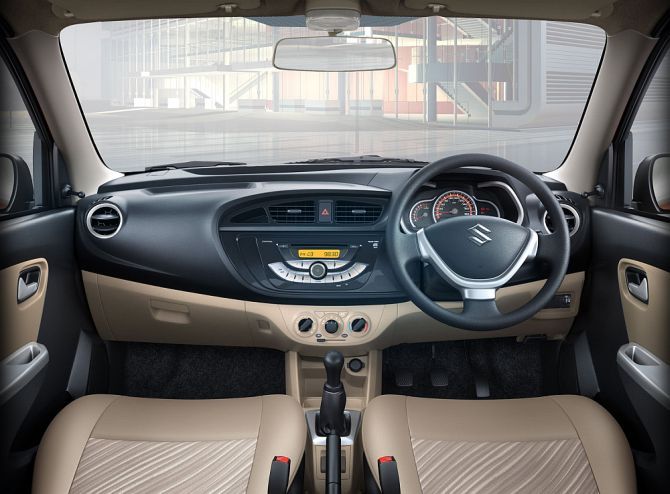
Photograph: Kind Courtesy, Maruti Suziki
October was a sober month for car market leader Maruti Suzuki.
However, for Rishi Goel, director of Shivam Auto, a Maruti dealer, it was not so.
Sales at his two Mumbai-based dealerships rose 30-40 per cent, with people queuing for test drives and product information.
The curiosity was for the new gearbox Maruti Suzuki introduced in its latest model, the Alto K10, and for the hatchback Celerio. Market watchers say this automated manual transmission will revolutionalise driving experience.
Two in every five Celerios being sold by Maruti are now equipped with the AMT technology.
The waiting period on the car, down to two months, is better than the four months for the Alto K10 automatic gear shift (another term for AMT).
Automatic gear shift has freed the consumer from using the clutch for gear changes. Built-in electronic units negate the need for manual intervention to control and select gears.
And, the driver can change his preference and switch to manual transmission anytime while on the drive.
Photograph: Kind Courtesy, Maruti Suzuki
Auto gear shift also prevents a vehicle from stalling because an on-board computer selects the right gear even during the manual drive mode and keeps the engine running.
Maruti claims that as gear changes are at optimal fuel economy levels in an AMT, this is better than manually operated variants.
Maruti claims fuel efficiency of 23.1 kmpl in the AMT as compared to 22 kmpl in a manual one.
Saju Mookken, country manager, Magneti Marelli India, said: “AMT has transformed the way the consumer has looked at the technology. Fuel economy is three to five per cent better than manual transmission.
"Presently, only one per cent of cars sold in India have automatic transmission.
"The AMT buyer gets the comfort of an automatic at a price that is slightly higher than manual.”
Magneti Marelli, a Fiat Group subsidiary, is the only supplier of AMTs in India, with supplies to Maruti Suzuki and Tata Motors.

Photograph: Kind Courtesy, Maruti Suzuki
From direct imports from Europe, the Italian company is forming a joint venture with Maruti Suzuki and Suzuki Motor Corporation for a manufacturing unit in Haryana, to begin production next year.
“We are also talking for supplies of AMT for small commercial vehicles up to six tonnes,” said Mookken.
Before zeroing on the AMT, Maruti tested three other transmission technologies, a breakaway from the traditional manual version.
The company tested the fully automatic technology in the A-Star hatchback but expectedly it failed to attract buyers as it was priced Rs 100,000 more than the manual variant and returned lower mileage.
“We reduced the price of the A-Star by Rs 30,000 and it was a runaway success.
"We realised that Indian buyers want the ease of driving without sacrificing mileage,” said C V Raman, executive director (engineering) Maruti Suzuki India. 
Photograph: Kind Courtesy, Maruti Suzuki
Maruti had also explored automatic transmission, continuously variable transmission and dual clutch transmission.
However, each of these failed on either price or mileage parameters.
“The fuel efficiency penalty on AT was about 15 per cent and the price penalty was more than Rs 1 lakh. In CVT, the fuel efficiency was not a penalty but the price certainly was higher.
"DCT was also tried but it was expensive and very nascent.
"AMT was finalised when we knew there would be no penalty on mileage and price,” said Raman.
Photographs: Kind courtesy, Maruti













 © 2025
© 2025